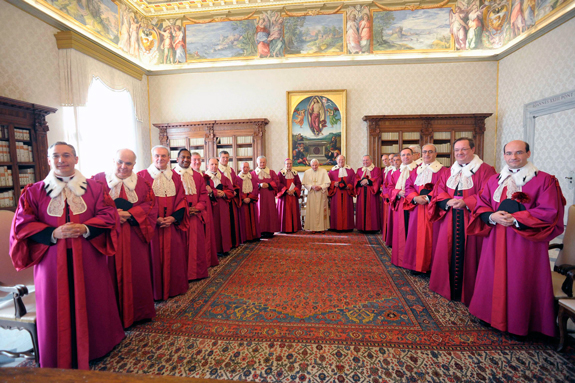by Carol Glatz

VATICAN CITY (CNS) – From picked pockets to a 1998 double murder and suicide, the Vatican legal system has dealt with a vast array of crimes and misdemeanors over the decades.
Now it has begun a formal inquiry into the case of the pope’s personal assistant, who has been implicated in the media-blitzed “VatiLeaks” scandal. Paolo Gabriele, the pope’s valet since 2006, was arrested May 23 by Vatican security for having unauthorized documents in his possession.
As the case unfolds in the coming weeks, many may wonder how the Vatican City State’s unique judicial system works.
Its legal foundations are rooted in the Code of Canon Law, papal decrees, the Lateran Pacts and Italian and Roman municipal laws.
Of the half-dozen different tribunal systems at the Vatican, just one deals specifically with the maintenance of law and order in the 108-acre country. The other systems tackle ecclesial matters.
When Vatican City State was created out of the Lateran Pacts in 1929, it adopted the Italian legal system for very practical reasons. Since the majority of people who are brought before the court are Italian residents, not Vatican citizens, it was believed necessary to have an established point of reference and direct link to Italian authorities.
Like the Italian system, the Vatican judicial system is an inverted pyramid. At the bottom level is the sole judge, Piero Antonio Bonnet, then there’s a three-judge tribunal, followed by an appeals court and the supreme court of appeals at the top.
Lay lawyers and judges staff the bottom two courts while the appeals court includes clerics. The supreme court of appeals is led by three cardinals. U.S. Cardinal Raymond L. Burke is president.
The Lateran Pacts established that anyone who commits a crime on Vatican property, even if it is a Vatican employee, can be handed over to Italian authorities and be tried in Italian court.
The treaty also stipulated that crimes committed in St. Peter’s Square, an open area that borders on Italian territory, fall to the Italian police. That is why Italians took over the investigation and trial of Blessed John Paul II’s would-be assassin, Mehmet Ali Agca, when he shot the pope in 1981.
The Vatican legal system has modified some aspects of the Italian system it’s based on. For example, it only uses civil laws that do not conflict with Catholic teaching, especially those concerning divorce and abortion.
It also fixed some of the problems that plague the Italian system – like the glacial speed with which it addresses and resolves cases.
The Vatican has sped things up by decriminalizing a series of minor offenses – such as shoplifting in Vatican stores – which allows the sole judge to resolve them without having to go to trial.
Jesuit Father Federico Lombardi, Vatican spokesman, told reporters that in the case of Gabriele, the first phase of a preliminary investigation was completed by a Vatican tribunal judge, Nicola Picardi.
Bonnet, the sole judge, began the next step of the formal investigation, which will include a preliminary questioning of the suspect in the presence of his two lawyers and Vatican judge Picardi.
The next stage of the investigation will be to decide whether the evidence points to a possible criminal offense, in which case Gabriele would be called to stand trial. If the evidence does not indicate criminal action, he would be acquitted.
If they decide to go to trial, the court could also decide whether to turn to the Italian justice system for assistance, Father Lombardi said.
Even though no cardinals have been questioned in the initial inquiry, “hypothetically speaking,” it is unlikely that a cardinal could be interrogated by the Vatican magistrates, the spokesman said.
“Cardinals answer to the pope,” he said. “With anything involving a cardinal, the Holy Father would have to be informed and decide how to proceed.”
The last serious crime the court and its judges had to deal with was a 10-month investigation in 1998, which determined that a young Swiss Guard shot and killed the Guard’s commander and the commander’s wife before taking his own life.
The cases that normally come across the sole judge’s desk include contested parking tickets, civil suits involving compensation for injuries suffered at the Vatican, employee theft, forgery and the especially rare instances of small-time fraud or embezzlement.
The vast majority of penal cases handled by the court involve theft, especially by pickpockets, but the perpetrators usually are not caught.
Per capita, Vatican City has the highest crime rate in the world.
According to the most recent published statistics, 226 criminal cases were reported in 2011 – actually half the number of cases reported in 2006 when it was almost one crime per resident in a country with only 492 inhabitants.
But those figures are deceiving since the high crime rate stems from the sheer volume of people – some 18 million each year – that stream through the Vatican to visit St. Peter’s Basilica and the Vatican Museums.
Recent reforms in Vatican norms and laws – for instance, the 2008 creation of an agency regulating and overseeing workers’ health and safety – also have increased the number of civil suits, which counted 640 in 2011.
The Vatican also adopted new laws in 2011 as part of its efforts to meet international norms against money-laundering and financing terrorism.
